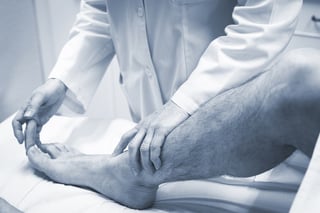
Treating leg and foot ulcers.
A new Article published in Clinical Endocrinology News discusses the treatment of patients with leg ulcers. Authors noted the first-line treatment for venous leg ulcers is compression therapy, which may be risky in patients with arterial disease and may result in ischemia. The compression typically comes from a special stocking or bandage. Although often prescribed and essentially effective, crutches, wheelchairs and bed rest rarely work in practice for diabetic patients. The "gold-standard" for achieving pressure redistribution for diabetic foot ulcers is by total contact casting. With the use of a specially designed cast, patients are able take weight off the foot also referred to as "off-loading". The FDA has recently expanded the approved indications for NPWT devices, which now include chronic, acute, traumatic, sub-acute, and dehisced wounds. It adds, however, that “NPWT dressings are not appropriate for ischemic wounds because they may cause necrosis of the wound edges. They are also contraindicated for wounds associated with untreated osteomyelitis, fistulas to body cavities or organs, malignancy, and exposed arteries or veins within the ulcer bed.” They also note hydrogen peroxide and povidone-iodine are toxic to human tissue and prevent re-epitheliazation of a wound, and gentle soap and water should be used instead. Films should be reserved for wounds with minimal exudate and hydrogels are best suited for dry wounds, or those with limited exudate. Hydrocolloids should not be used for wounds with too much exudate because the large amount of moisture will cause the dressing to separate or cause periwound maceration. Fibrous dressings, including alginates and hydrofibers, have very high absorbency and are used for wounds with heavy exudates and in fact alginates require moisture to function, thus they should not be used over dry wounds.
Many European doctors and ozone specialists here use ozone limb bagging as part of wound care treatment.
Use this information to take the quiz below and see how much you know!1. In treatment of patients with leg ulcers, compression therapy __________.
A. Is the first-line treatment for venous ulcers
B. May be used for wounds featuring edema and inflammation
C. May cause ischemia in patients with arterial disease
D. All of the above
2. Which of the following foot-offloading methods is the gold standard for pressure redistribution treatment of patients with diabetic foot ulcers?
A. Crutches
B. Total contact casts
C. Wheelchair
D. Bed rest
3. Negative pressure wound therapy (NPWT) is appropriate for management of any of the following wound types EXCEPT __________.
A. Acute
B. Chronic
C. Dehisced
D. Ischemic
4. True or False. Povidone-iodine may be applied as a topical antiseptic solution on chronic leg wounds.
A. True
B. False
5. Which of the following types of leg wound dressing may be used to manage wounds with heavy exudate?
A. Alginates
B. Films
C. Hydrogels
D. Hydrocolloids
We offer full pre-diabetes and diabetes screenings in all of our offices. If you want calorie restriction and high levels of protein, you can make a great protein shake for breakfast and lunch with Xymogen's OptiCleanse GHI Sugar and Stevia free or OptiMetaboliX 2:1 OptiMetabolix 2:1 offers the best blood sugar regulation. Chai, Chocolate, Vanilla Delight and Chocolate Mint are delicious flavors that everyone loves. Keep a blender handy at work or home and you can whip up a protein shake that will balance your blood sugar all day long.
One of the best treatments is ozone chelation. Both therapies been shown to reverse Type II diabetes. Chelation removes heavy metals that cause cardiovascular disease and free radical activity. Ozone kills pathogens that damages organ systems including the pancreas. The National Institutes of Health TACT Trial to Assess Chelation Therapy showed that 37% of patients with diabetes out of a total of 1700 patients had a 41% reduction in cardiac events, 52% drop in recurrent myocardial infarctions and 43% reduction of deaths. Chelation should become mainstream treatment for Type II diabetes. We have specialized medicines to stabilize blood sugar regulation that can be added to your treatment. Momordica, Leptandra, Chelidonium are a few injectables to mention.
Diabetes Management Breakthroughs
Diabetes and Cardiovascular Health
Answer Key:
1. D. All of the above
2. B. Total contact casts
3. D. Ischemic
4. B. False
5. C. Hydrogels


